Lorem ipsum dolor sit amet, consectetur adipiscing elit. Curabitur eleifend tortor nec augue pretium

In 2019, the UK became the first country in the world to declare a climate and ecological emergency, committing to achieve net zero by 2050. The goal may seem benevolent, but there are several challenges to overcome.
Among the most pressing challenges is the construction sector, which, despite its significant economic contribution and significance, remains one of the most resource-intensive industries globally. It consumes a finite supply of raw materials at unprecedented rates, generates around 40% of global carbon emissions and waste, and locks in carbon-heavy infrastructure for decades.

In the UK, construction and demolition waste (CDW) represents 62% of all waste, which includes over 10% of the unused raw materials. Half of this waste ends up in landfills, with less than 2% being upcycled. Recognising these impacts, the London Plan 2021 introduced ambitious targets: to achieve 95% recycling, reuse, or recovery of CDW and ensure 95% beneficial use of excavation waste.
As the nation faces climate commitments, housing shortages, health and social issues and infrastructure demands, the way responsible consumption of raw materials and construction waste is managed will determine whether the UK can achieve net zero.
This article emphasises the challenges in achieving zero avoidable waste (ZAW) in construction by addressing critical gaps in monitoring, measurement, and stakeholder engagement within a densely urbanised borough like Westminster City. It highlights the invisible mental barriers and systemic issues contributing to excessive construction and demolition waste (CDW), revealing poor compliance with circular economy principles and minimal upcycling. Drawing from academic literature, stakeholder interviews, and practitioner insights, the planetary boundaries framework and the iceberg systems thinking are used to demonstrate the urgent environmental and social implications of unregulated CDW.
Local governments responsible for planning approvals need to implement local policies drawn up in collaboration with all internal and external stakeholders to measure and monitor CDW in their borough, which will drive circular construction and innovation in the longer term.
Building on this foundational analysis, a targeted, four-year strategic action roadmap is recommended to implement a borough-wide CDW monitoring and measurement (M&M) system. This will set out SMART milestones to capture baseline data and to achieve full compliance with UK waste legislation and the London Plan 2021 by 2028, and will drive circular construction and innovation through local policies and urban governance.
As a member of ISEP and resident of Westminster City Council (WCC), I participated in the WCC Citizens Climate Assembly in 2023, which was one of the warmest record-breaking summers. Several recommendations came out of this assembly, the most popular being the council providing support and incentives for construction firms to embrace a circular economy. With over two decades of international professional experience in consulting and governance, this prompted me to upskill by taking on a part-time post-graduate diploma from the Cambridge Institute of Sustainability Leadership (CISL).
Supervised by CISL, I used WCC as a case study since it is a dense London borough grappling with housing pressure, climate targets, and systemic waste challenges. It not only houses the national government but also has financial affluence, positioning it as a model council and a blueprint for sustainable construction governance. A SWOT and stakeholder analysis was conducted specifically for WCC, and primary and secondary research included a review of academic / business journals, industry reports and council officers’ surveys. This forms a robust, evidence-based case for embedding circularity in WCC’s construction practices, enabling the council to mitigate scope 3 emissions, meet its borough-wide 2040 net-zero targets, and influence wider urban sustainability policy at a national level.
The figure below tells a stark story of why construction waste cannot be ignored:
The consequences of irresponsible CDW disposal ripple across society: landfills consume scarce urban land, cause loss of biodiversity, and expose communities to health risks from dust and pollution. Economically, inefficiencies inflate project costs and increase vulnerability to material price shocks and affordability. Socially, unmanaged waste undermines affordable housing and healthcare costs and erodes public trust.
Circular economy guidance statements by the UK Green Building Council and the London Mayor require major developments to evidence hard-wired circular economy principles into their plans, schemes, and projects. The London Plan 2021 sets a target of 95% recycling/reuse/recovery of CDW and the beneficial use of 95% excavation waste.
Regulators, data aggregators, and the global construction industry currently rely on the construction demolition waste recovery rate (CDWRR) as a baseline for measuring progress in waste reduction. However, CDWRR is a low-quality recycling rate for backfilling in landscaping or roads that should be a “last-resort option” because it can overshadow incentives for higher-value reuse or recycling.
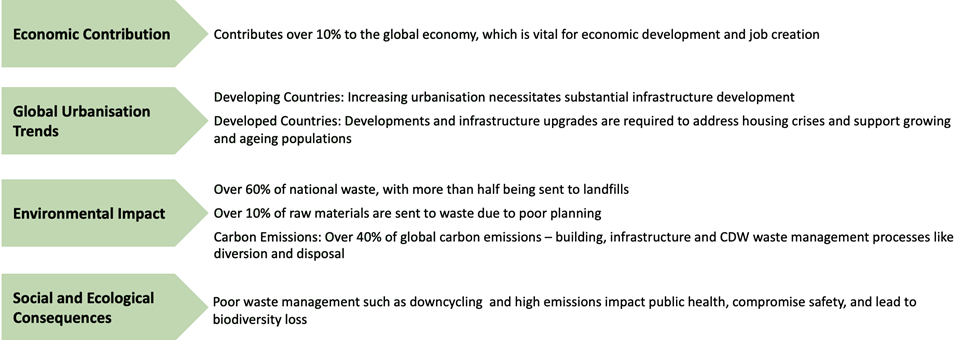
The UK Construction Industry Waste Report 2023 calculates “the current average carbon emissions associated with waste management during construction to be 190,000 kg CO2e per £1m project Capex, based on transport emissions and waste management disposal and recycling methods”. The current UK social housing shortfall crisis is estimated to cost over £200bn in new constructions.
In such a scenario, it is imperative that a focused approach is taken to address this serious challenge. Although managing waste effectively is an ongoing challenge in the construction industry, there are numerous pathways to improve efficiency, reduce environmental impact, and capitalise on sustainable practices. The construction sector can make significant strides toward improved sustainability by addressing these challenges through innovative solutions and collaborations.
The figure below shows the planetary boundaries framework from Stockholm Resilience Centre confirming that six boundaries were transgressed in 2023, four of which can be associated with construction and its waste impact. The impact is unquantifiable as this framework is used at a global scale, but a correlation can be clearly inferred.
Addressing the CDW challenge presents several opportunities, as evidenced by various research studies, summarised below:
Minimising waste reduces dependency on raw materials and avoids market shortages and price volatility. It promotes responsible consumption, helps reduce environmental impacts, and conserves natural biodiversity. Furthermore, it attracts environmentally conscious consumers and investors and gains loyalty, ensuring long-term business viability and resilience.
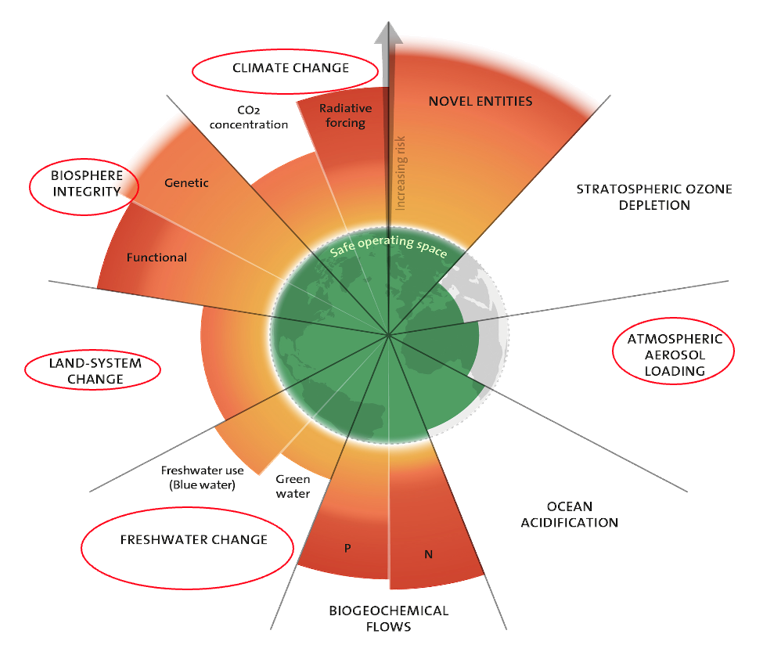
Innovation in construction, product development, and manufacturing fosters collaborative industry partnerships and generates green jobs, driving social equality and community development. Innovative solutions emerging in industry include:
Consequently, these opportunities help achieve several UN SDGs, as indicated in the figure below:
The criticality and benefits of a circular construction and ZAW Strategy are indisputable. However, nominal client/owner requirements are often the main reason for construction waste. A uniform baseline for good circular practices, data collection, monitoring, delivery, and reporting to measure progress with clear policies and regulations is needed.
Stakeholder collaboration and engagement are vital. Understanding the barriers and drivers from the stakeholders’ perspective and key influencers of current industry developments is imperative for driving circularity.

Due to the risk of market volatility and price fluctuations of finite natural resources, the sector will benefit considerably from transitioning to a circular approach. However, scarce knowledge on the benefits and long-term value among stakeholders, high implementation costs, and reservations about the trade-offs obstruct progress towards circularity. Without widespread training, industry collaborations, data sharing, and technical literacy, even well-designed circular frameworks risk remaining on paper rather than being embedded into practice.
Understanding the mental models of the related stakeholders is important. A useful tool for this is the iceberg model framework (figure below), a systems-thinking tool that uses the metaphor of an iceberg to decipher how surface-level events are triggered by less visible patterns, structures, and beliefs. It has been used to map the primary and secondary insights uncovered during business research.
While such frameworks are robust, there is a lack of an ecosystem and uniform data collection, impact measurement and enforcement mechanisms. Consequently, there are isolated initiatives across the industry, as evidenced in a few reports such as Relondon (2021), GLA Planning (2022). This is also evident from the assumptions that have emerged after mapping all data in the iceberg model. The visible waste piles are symptoms of deeper structures (weak regulation, poor data, limited incentives) and entrenched beliefs (recycled equals high cost/effort and low quality).
This article builds a case for WCC to go beyond their planning approval remit to initiate a CDW M&M. Factual data is important for developing evidence-based policies, as it allows for:
Adopting robust CDW M&M will not only drive circular construction and the much-needed innovation but also enable improved service delivery, enhanced transparency, public trust, informed policymaking, and innovation in the sector. Most importantly, it will avoid the risk of greenwashing.
To address the multidimensional complexity of modern challenges like sustainable urban governance, the levers in consideration must be policy, economics, technology, collaboration, leadership, education, transparency, liability and market forces, which acknowledge the interconnected nature of stakeholders, resources, and external influences. These mutually reinforcing levers provide a vigorous framework for change and ensure alignment with sustainability objectives and societal needs, and explore cross-sector collaborations in public governance, emphasising the role of partnerships, shared goals, and adaptive leadership in achieving sustainable change.
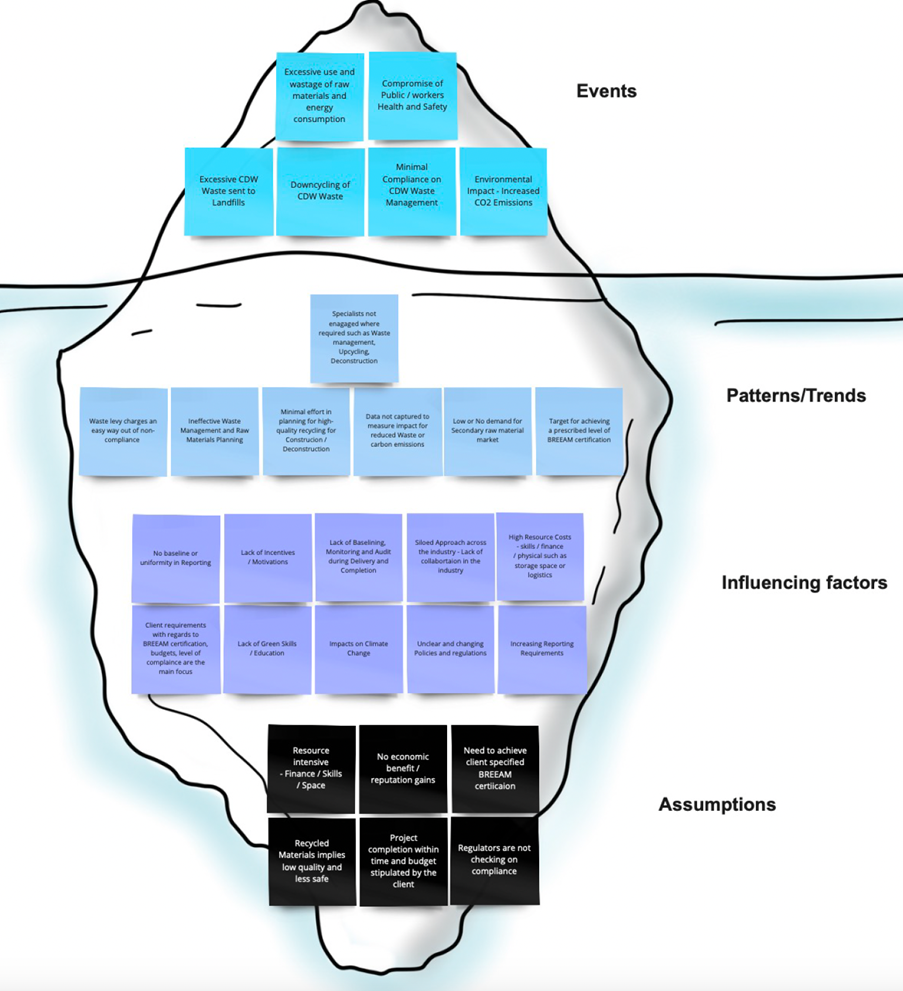
Considering the large-scale complexity of urban governance and multi-stakeholder, multi-organisation involvement, a hybrid change approach is best suited here. Steps one to five from Kotter's model (shown right) are the first steps to creating organisational momentum and securing council leadership buy-in to establish a sense of urgency, guide the coalition, develop a change vision, communicate the vision and remove obstacles.
Subsequently, the ADKAR model complements this approach by emphasising stakeholder adoption and offering a comprehensive approach to urban governance reforms. Such integration ensures top-down alignment and converges with bottom-up grassroots participation, addressing the complexity of urban systems.

The figure to the left summarises the three-term roadmap with key SMART milestones over a four-year period. As the implementation spans organisations and diverse stakeholders with competing priorities, a pragmatic, agile, and collaborative approach is vital to success.
The figure below it details a short-term action plan proposes using both models together to yield the best results.
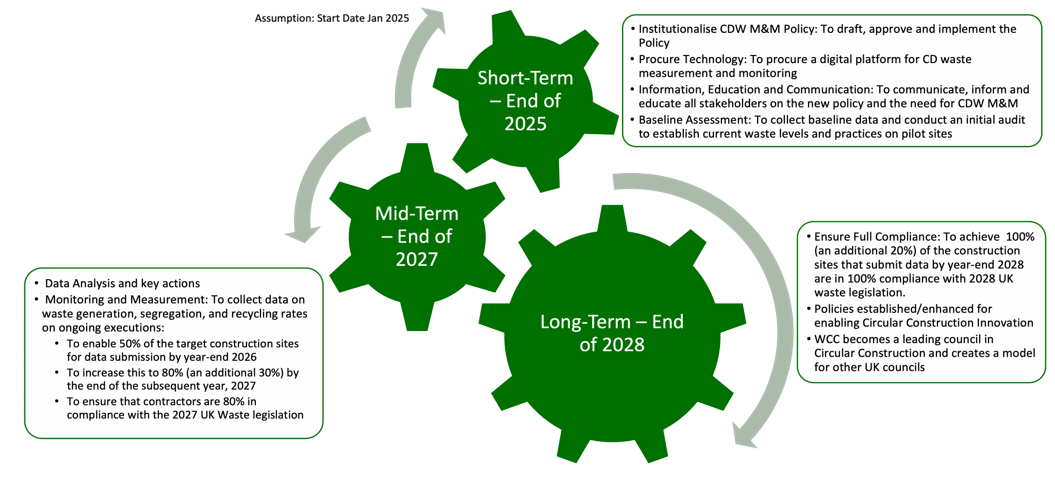
As with any initiatives, the key performance indicators (KPIs) below are some recommended measures for clear milestones, evaluating progress and performance against the unified objectives. The KPIs must be internally aligned within the council and communicated clearly to the stakeholders:
Annually: % reduction in waste generation / carbon emissions year on year
Half-yearly: Stakeholders' feedback on waste practices
Quarterly: Number of waste streams separated; percentage of segregated waste; waste diversion rate; compliance with waste management plans; recycled materials used in construction; timely submission of waste reports; cost per ton of waste managed; savings from waste recycling and reused materials; carbon footprint of waste management; percentage of contractors trained in waste management; materials reused on site; revenue from the sale of recycled/used materials.
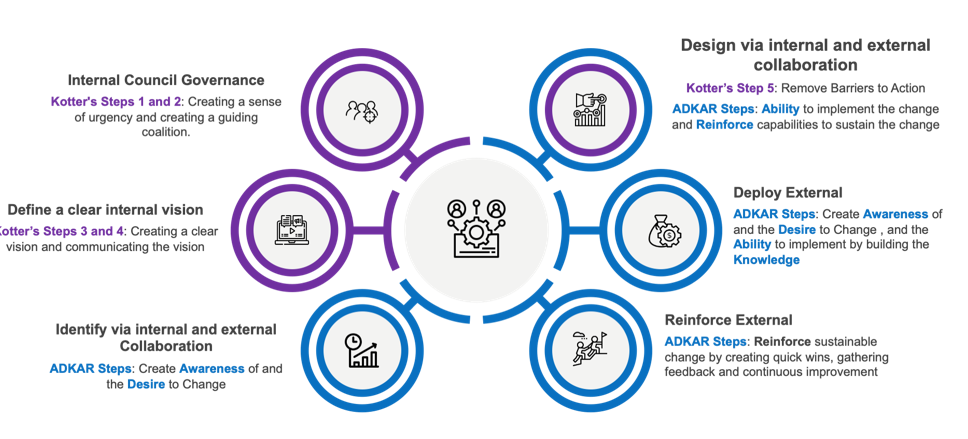
Most of the local councils’ environmental sciences team normally monitor construction sites to ensure compliance with their respective construction practices through audits of noise pollution’ and traffic management, the service cost of which is borne by the contractors. With this in-house monitoring expertise on a cost-recovery basis, the scope can extend to CDW M&M. Some financial costs incurred in capacity building and the initial setup may not be recoverable.
When viewed through an economic, environmental, and societal lens, the benefits of implementing the CDW M&M system outweigh the unrecoverable costs. While initial investments might seem significant, the long-term savings, proactive compliance, and enhanced sustainability position the respective council as a leading, forward-thinking, and environmentally responsible authority.
Construction waste is not an inevitability but a design flaw. The concept ZAW and circular construction challenges cities, councils, and contractors to rethink how buildings are designed, delivered, and dismantled.
The Westminster business case illustrates that while barriers are real, such as escalating costs, a lack of data, and weak enforcement, solutions do exist, such as monitoring, incentives, collaboration, and mindset shifts.
The message is undisputed:
The opportunity is immense. If local authorities and industry take up the challenge, the sector can transform from one of the planet’s largest polluters into a cornerstone of the circular economy.
Rashmi Rungta is an ISEP member with over 25 years of global experience spanning consulting, technology, and governance. She has expertise in embedding ESG principles into boardroom decision-making, driving sustainable business transformations, and fostering inclusive, purpose-driven cultures, and is committed to advancing circular economy solutions and climate-resilient strategies.